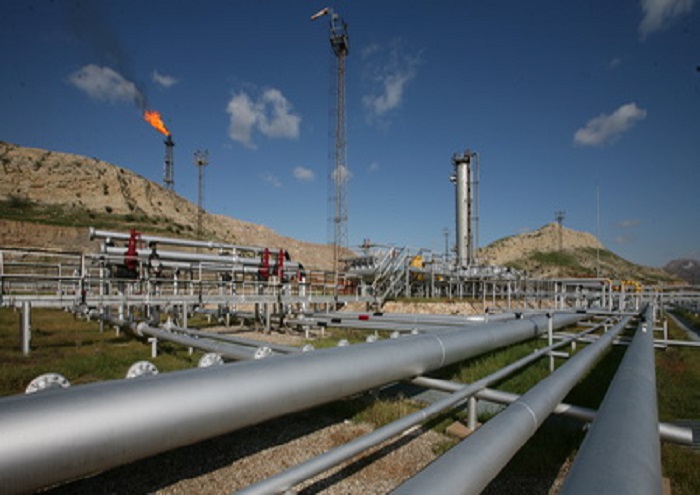The Iranian Central Oil Fields Company (ICOFC) assigned to a domestic company a project for gathering flare gas at the Cheshmeh-Khosh oil field. Under this agreement, 67 mcf/d of associated petroleum gas would be gathered over six months. The flare gas gathered at this oil field is estimated to earn the country $5 million a year. Furthermore, ICOFC is implementing other flare gas gathering projects across the country with a view to reducing harmful impacts on the environment and creating value-added, offering investment opportunities and creating businesses. In Naftshahr, Sarvestan and Saadatabad, ICOFC is currently gathering 26.1 mcf/d of gas. The Dehloran gas gathering and gas compressor station projects are under way with an investment of €125 million. A gas gathering project in the Khesht field is expected to be awarded to contractor in the near future. The Cheshmeh-Khosh oil field is located in the western Ilam Province. Discovered in 1964, it became operational in 1977. The oil produced at this field is processed at a production center prior to being carried in a 153-km-long pipeline to the Ahvaz 3 production complex, which would finally feed refineries or go to Kharg Island for export. Ahmad Rajabi, director of production at ICOFC, told "Iran Petroleum" the objective behind the Cheshmeh-Khosh gas gathering project was to appropriately use national assets, domestic potential in the manufacturing of such widely-used equipment as compressors, develop the economy and minimize or eliminate environmental pollution.
The full text of the interview is as follows:
First of all, I would like to ask you about the beginning of the Cheshmeh-Khosh gas gathering project and its objective?
An auction bid was held last calendar year for selling associated gas gathered at Cheshmeh-Khosh. An agreement was signed with a domestic company later that year. The project started last March after allotment of the necessary land.
What’s the objective behind this project?
The objective is to gather associated gas at Cheshmeh-Khosh and recover light gas and condensate including LPG and C5+. Appropriate use of national assets, using domestic potential in the manufacturing of such equipment as compressors, economic development, elimination or maximum reduction of environmental pollution are sought through this project. Completing the value chain in the oil and gas process, and creating generative opportunities for investment would create job opportunities and make business prosperous in western Iran.
What is the share of domestic companies in the project? Could you provide us with more details?
This project includes design, supply of commodity, construction and operation of gas compressor units and condensate recovery in Cheshmeh-Khosh. Domestic companies manufacture 85-90% of commodities required in the project.
How much gas would have been recovered once the project becomes operational?
In this project, about 67 mcf/d (1.895 mcm/d) of gas would be gathered. One cubic meter of gas worth 0.75 cents. Therefore, the gathered associated gas would be valued at $14,000 a day. This amount of gas is planned to be gathered for one year.
Which phase is the project in now?
Currently, gas sale, land delivery and mine-sweeping agreements have been signed. Design has been carried out and commodities have been ordered, and compressors have been manufactured. Construction has already started.
How much is the project estimated to be valued?
This project would be valued at $5 million a year, which would be achieved through selling gas. The contractor will make revenue from selling light gas and gas condensate.
How will this project affect the environment, the economy and in broader terms completion of the value chain?
Implementing this project will prevent the sales of associated gas and reduce environmental pollution, make business prosperous, create jobs and value-added.
Why hasn’t the project been operational sooner?
The main project for gas gathering at Cheshmeh-Khosh and its satellite fields has been done within the framework of development of 16 ICOFC-administered fields. It has had 85-90% progress now. The objective of this project is to deliver associated gas to the NGL 3100 plant. However, in light of operation and launch of the NGL 3100 plant by next year, the gas gathering project would be completed in parallel with the NGL 3100 plant. That is why we decided to auction off the Cheshmeh-Khosh associated gas prior to the commissioning of the NGL 3100 plant.
What about development of the Cheshmeh-Khosh oil field?
The Cheshmeh-Khosh field is currently producing 80,000 b/d. Since the consortium in charge of developing the Cheshmeh-Khosh, Dalpari and East Paydar fields has suggested improved oil recovery (IOR) for these fields, it has been tasked with envisaging enhanced oil recovery (EOR), too for a 10-year period.
Have environmental considerations been taken into account in the development of the field?
As far as IOR and EOR are concerned, we plan to use downhole pumps. Regarding the environmental aspect of associated petroleum gas, the contractor has not offered any specific plan. Therefore, the initial plan developed by ICOFC for gas gathering and delivery to the NGL 3100 plant is still envisaged. Before the operation of this plant, associated gas would be gathered to be auctioned off.
How do you see the economic, environmental and social impacts of gas gathering projects?
Associated gas gathering projects prevent any waste of gas and environmental pollution. By completing the value chain of gas production, light gas (for injection into oil reservoirs or feeding into national gas network) and gas condensate will be created, business will become prosperous and jobs will be created near oil facilities, particularly in underprivileged areas. Furthermore, in case of light gas injection into oil reservoirs, the recovery rate will increase. In developing oil fields, planning should be made so as to gather and consume associated petroleum gas at the same time as the field is developed and operated so that no gas would be flared at any time.
by Marjan Tabatabaei
Courtesy of Iran Petroleum


Your Comment